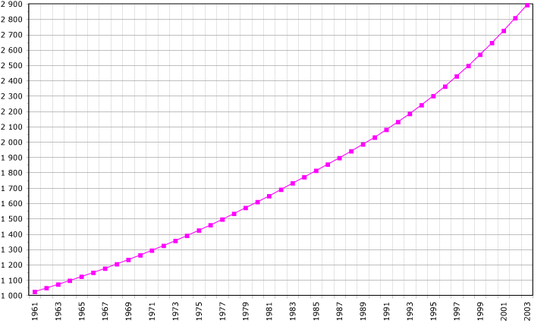Demographics of Mauritania
2007 Schools Wikipedia Selection. Related subjects: African Geography
Population: 2,667,859 (July 2000 est.)
Age structure:
0-14 years: 46% (male 617,077; female 614,961)
15-64 years: 52% (male 677,238; female 697,524)
65 years and over: 2% (male 25,417; female 35,642) (2000 est.)
Population growth rate: 2.94% (2000 est.)
Birth rate: 43.36 births/1,000 population (2000 est.)
Death rate: 13.97 deaths/1,000 population (2000 est.)
Net migration rate: 0 migrant(s)/1,000 population (2000 est.)
Sex ratio:
at birth: 1.03 male(s)/female
under 15 years: 1 male(s)/female
15-64 years: 0.97 male(s)/female
65 years and over: 0.71 male(s)/female
total population: 0.98 male(s)/female (2000 est.)
Infant mortality rate: 78.15 deaths/1,000 live births (2000 est.)
Life expectancy at birth:
total population: 50.76 years
male: 48.7 years
female: 52.87 years (2000 est.)
Total fertility rate: 6.29 children born/woman (2000 est.)
Nationality:
noun: Mauritanian(s)
adjective: Mauritanian
Ethnic groups: mixed Maur/black 40%, Maur 30%, black 30%
Religions: Muslim 100%
Languages: Although Arabic is the official language of Mauritania, the country speaks a distinctive dialect known as Hassaniya. The country also speaks a number of other languages, Pulaar (national), Soninke (national), Wolof (national), and French. And In addition to those, " Nemadi" and " Imraguen" have been dubiously reported by some sources to be separate languages (as opposed to dialects of Hassaniyya.)
Literacy:
definition: age 15 and over can read and write
total population: 37.7%
male: 49.6%
female: 26.3% (1995 est.)
Algeria • Angola • Benin • Botswana • Burkina Faso • Burundi • Cameroon • Cape Verde • Central African Republic • Chad • Comoros • Democratic Republic of the Congo • Republic of the Congo • Côte d'Ivoire (Ivory Coast) • Djibouti • Egypt • Equatorial Guinea • Eritrea • Ethiopia • Gabon • The Gambia • Ghana • Guinea • Guinea-Bissau • Kenya • Lesotho • Liberia • Libya • Madagascar • Malawi • Mali • Mauritania • Mauritius • Morocco • Mozambique • Namibia • Niger • Nigeria • Rwanda • São Tomé and Príncipe • Senegal • Seychelles • Sierra Leone • Somalia • South Africa • Sudan • Swaziland • Tanzania • Togo • Tunisia • Uganda • Western Sahara (Sahrawi Arab Democratic Republic) • Zambia • Zimbabwe
Dependencies and other territories
British Indian Ocean Territory • Canary Islands • Ceuta • Melilla • Madeira Islands • Mayotte • Réunion • St. Helena
